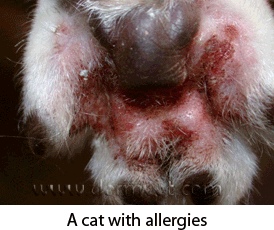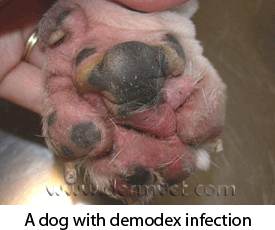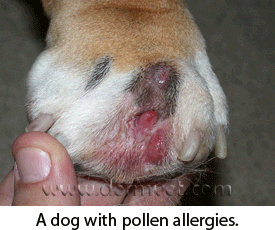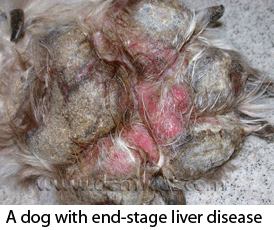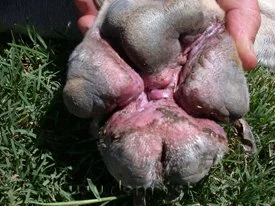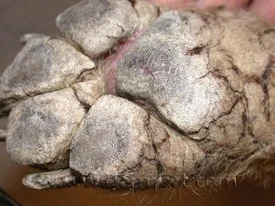Pododermatitis
-
The most common cause of pododermatitis is allergy, especially atopy (environmental allergy) and food allergies. The allergy can cause inflammation of many areas of the skin, including the feet. Many pets with pododermatitis can then develop a secondary bacterial or yeast infection.
In addition to allergies, other causes of pododermatitis include a form of mange (Demodex), fungal infections (ringworm or dermatophytosis), dilated (cystic) hair follicles, sterile granuloma, and autoimmune disorders such as pemphigus foliaceus. Foreign bodies such as plant awns or fox tails are frequently the cause of pododermatitis, although this will most often affect only one foot. There are also internal diseases, such as a failure of the liver, which can cause destruction (necrosis) of the foot pads, or hormonal disorders such as hypothyroidism or Cushing’s disease, which can make animals more prone to develop infections.
-
Any allergic pet should be considered prone or susceptible to developing pododermatitis. In addition, animals outside with greater exposure to foxtails, and ringworm in the soil are also at greater risk. Larger dogs may also be at greater risk of developing infections from hair shafts that have been pushed under the skin (similar to an ingrown hair), which can cause inflamed lumps between the toes.
-
Pododermatitis means inflammation of the feet and is considered to be more of a description, than an actual disease. Many underlying disorders result in pododermatitis.
-
Sometimes the inflammation is limited to just the feet, with no other site or region affected. The inflammation results in redness and an itch sensation in the feet. This can result in the pet licking and or chewing the feet, nails, and even foot pads. The feet themselves can be red or irritated, with red or brown staining, and the accumulation of oily/waxy debris, especially in dogs with deep folds in between their toes. When a secondary infection develops, this can cause even more itch, as well as an abnormal odor. Other changes that may occur include a generalized swelling of the feet or more local swellings (nodules) in between the toes. These will usually eventually open and drain a pus-like or bloody discharge. These draining tracts, called fistulas, can occur in both an upward or downward direction in the foot. This will usually lead to scar tissue formation, which makes treatment even more difficult and lengthy.
-
See Clinical Signs.
-
When presented with a patient with inflammation of the feet, your veterinarian will usually start with two diagnostic tests. Skin scrapings are necessary to look for and find demodex mites. In addition, samples to check for bacteria and yeast (cytology) should be obtained since these are such common secondary problems for a pet with pododermatitis. In addition to treating the infections, if an underlying allergy is suspected, an allergy work-up may be started such as a food trial, testing for environmental allergies, and/or a parasite treatment trial. Depending on the findings of the physical exam, additional testing such as biopsies, cultures, or surgical “exploration” of the lesion looking for foreign bodies may be required.
-
The sooner the underlying cause and secondary infections are identified and treated, the better the outcome will be. Because chronic cases of pododermatitis can develop significant amounts of scarring in the feet, this can make treatment more difficult, and recurrence of disease more likely.
-
Because pododermatitis can have multiple different causes and secondary infections, multiple different therapies are usually required. Identification and treatment of the underlying cause are necessary if a complete and permanent cure is the goal. Systemic (internal) antibiotics or antifungal medications may be required for three weeks or longer for secondary infections. Topical products may also be recommended, depending on the severity of the condition. Many of the more advanced cases of pododermatitis are not going to improve with topical medications alone, but they can be very helpful when combined with the appropriate internal medications. When medical treatment alone is not curative, surgical or laser removal of chronically scarred interdigital nodules may be needed.
-
Inspecting the feet, including in between the toes daily during foxtail season or when the pet has been outside can allow removal of foxtails before they penetrate into the foot and cause damage. The best way to prevent chronic pododermatitis is to seek prompt veterinary care as soon as any allergic symptoms (such as licking of the feet or redness and inflammation between the toes) are noted.

